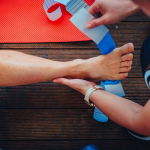The Importance of Stretching!!
In any sport a good conditioning program is vital for developing power, skill, endurance, flexibility and improved reaction times. Training routines will vary depending on the sport and the time of year. The aim of training is obviously to allow the body to undergo the physiological adaptation specific to the sport. The bones, the cardiovascular system, the muscles, tendons and ligaments adapt in response to training to give improved performance. To achieve maximum efficiency, a well designed ‘warm up and warm down’ routine is needed. This includes stretching of important muscle groups, such as, our legs, hips, arms and shoulders. Stretching has been shown to improve flexibility, help prevent injuries and improve performance.
Warming up
-
- Jogging – a slow gentle jog for a few minutes gets the blood flowing. Increasing the blood flow to the muscle increases their temperature and oxygen content. This leads to greater efficiency.
-
- Stretching
-
- slow gentle stretching, begin to judge or feel your flexibility
-
- watch your stretching technique. Stretches can be useless if not done properly. Position the body correctly and concentrate on the muscle being stretched.
-
- don’t compete with others, flexibility varies between individuals.
-
- gently hold the stretch in a comfortable position for 10-15 seconds.
-
- DO NOT over stretch or cause pain
-
- DO NOT bounce, bouncing or ballistic stretching causes the muscles to contract and no improvement is gained. Muscles can also be damaged.
Warming Down
-
-
- Keep moving – after the event it is important to keep moving for 10-15 minutes afterward. This allows the heart rate to gently return to normal. Continuing movement also flushes lactic acid and other metabolic products out of the muscles, reducing the potential for cramping and pain.
-
-
-
- Stretching – Stretching as for warm up period. Stretching relaxes muscles and decreases stiffness and pain the next day.
-
The warm up and down periods will help reduce lower-limb injuries such as, hamstring strains and Achilles tendonitis. If pain or lower-limb injuries are a constant problem, seek advice from one of our podiatrists. Podiatrist can identify structural variations in the foot, leg and hip. These alignment problems, may be the underlying cause of muscle imbalances and injuries. Orthotic treatment are often used as part of an overall treatment program to improve lower limb alignment.


